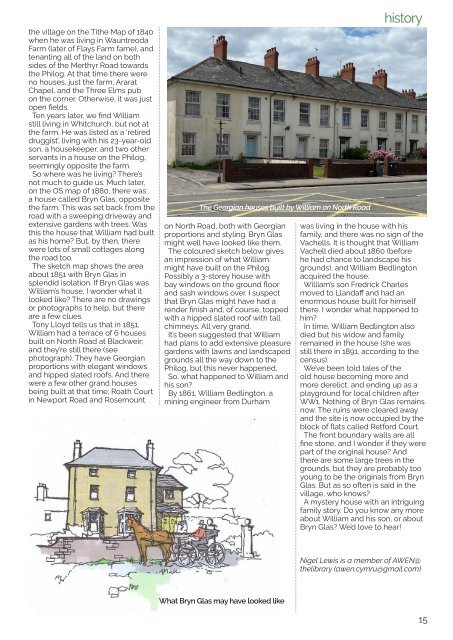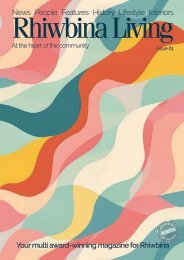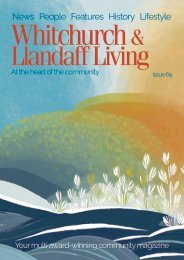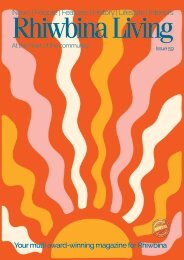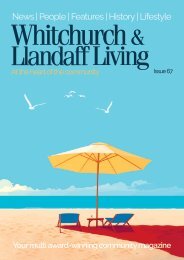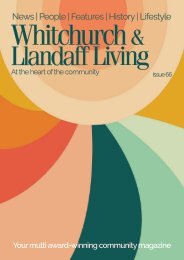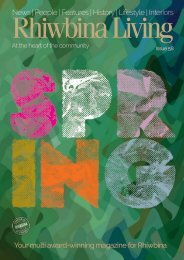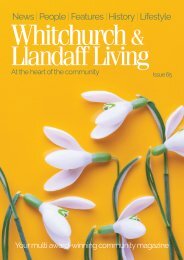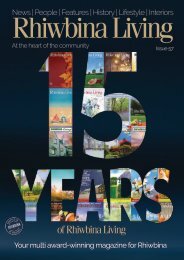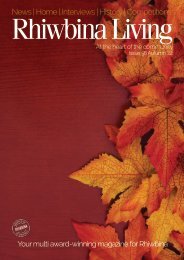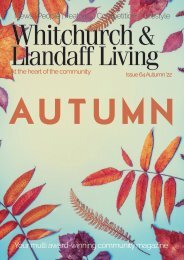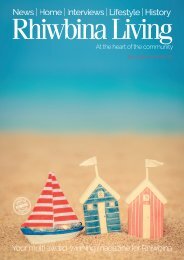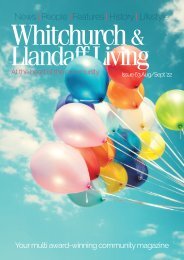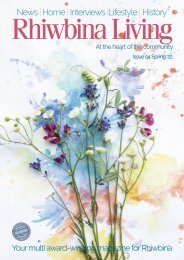Whitchurch and Llandaff Living Issue 68
Issue 68 of the award-winning Whitchurch and Llandaff Living magazine.
Issue 68 of the award-winning Whitchurch and Llandaff Living magazine.
You also want an ePaper? Increase the reach of your titles
YUMPU automatically turns print PDFs into web optimized ePapers that Google loves.
the village on the Tithe Map of 1840<br />
when he was living in Wauntreoda<br />
Farm (later of Flays Farm fame), <strong>and</strong><br />
tenanting all of the l<strong>and</strong> on both<br />
sides of the Merthyr Road towards<br />
the Philog. At that time there were<br />
no houses, just the farm, Ararat<br />
Chapel, <strong>and</strong> the Three Elms pub<br />
on the corner. Otherwise, it was just<br />
open fields.<br />
Ten years later, we find William<br />
still living in <strong>Whitchurch</strong>, but not at<br />
the farm. He was listed as a ‘retired<br />
druggist’, living with his 23-year-old<br />
son, a housekeeper, <strong>and</strong> two other<br />
servants in a house on the Philog,<br />
seemingly opposite the farm.<br />
So where was he living? There’s<br />
not much to guide us. Much later,<br />
on the OS map of 1880, there was<br />
a house called Bryn Glas, opposite<br />
the farm. This was set back from the<br />
road with a sweeping driveway <strong>and</strong><br />
extensive gardens with trees. Was<br />
this the house that William had built<br />
as his home? But, by then, there<br />
were lots of small cottages along<br />
the road too.<br />
The sketch map shows the area<br />
about 1851 with Bryn Glas in<br />
splendid isolation. If Bryn Glas was<br />
William’s house, I wonder what it<br />
looked like? There are no drawings<br />
or photographs to help, but there<br />
are a few clues.<br />
Tony Lloyd tells us that in 1851,<br />
William had a terrace of 6 houses<br />
built on North Road at Blackweir;<br />
<strong>and</strong> they’re still there (see<br />
photograph). They have Georgian<br />
proportions with elegant windows<br />
<strong>and</strong> hipped slated roofs. And there<br />
were a few other gr<strong>and</strong> houses<br />
being built at that time; Roath Court<br />
in Newport Road <strong>and</strong> Rosemount<br />
The Georgian houses built by William on North Road<br />
on North Road, both with Georgian<br />
proportions <strong>and</strong> styling. Bryn Glas<br />
might well have looked like them.<br />
The coloured sketch below gives<br />
an impression of what William<br />
might have built on the Philog.<br />
Possibly a 3-storey house with<br />
bay windows on the ground floor<br />
<strong>and</strong> sash windows over. I suspect<br />
that Bryn Glas might have had a<br />
render finish <strong>and</strong>, of course, topped<br />
with a hipped slated roof with tall<br />
chimneys. All very gr<strong>and</strong>.<br />
It’s been suggested that William<br />
had plans to add extensive pleasure<br />
gardens with lawns <strong>and</strong> l<strong>and</strong>scaped<br />
grounds all the way down to the<br />
Philog, but this never happened,<br />
So, what happened to William <strong>and</strong><br />
his son?<br />
By 1861, William Bedlington, a<br />
mining engineer from Durham<br />
history<br />
was living in the house with his<br />
family, <strong>and</strong> there was no sign of the<br />
Vachells. It is thought that William<br />
Vachell died about 1860 (before<br />
he had chance to l<strong>and</strong>scape his<br />
grounds), <strong>and</strong> William Bedlington<br />
acquired the house.<br />
William’s son Fredrick Charles<br />
moved to Ll<strong>and</strong>aff <strong>and</strong> had an<br />
enormous house built for himself<br />
there. I wonder what happened to<br />
him?<br />
In time, William Bedlington also<br />
died but his widow <strong>and</strong> family<br />
remained in the house (she was<br />
still there in 1891, according to the<br />
census).<br />
We’ve been told tales of the<br />
old house becoming more <strong>and</strong><br />
more derelict, <strong>and</strong> ending up as a<br />
playground for local children after<br />
WW1. Nothing of Bryn Glas remains<br />
now. The ruins were cleared away<br />
<strong>and</strong> the site is now occupied by the<br />
block of flats called Retford Court.<br />
The front boundary walls are all<br />
fine stone, <strong>and</strong> I wonder if they were<br />
part of the original house? And<br />
there are some large trees in the<br />
grounds, but they are probably too<br />
young to be the originals from Bryn<br />
Glas. But as so often is said in the<br />
village, who knows?<br />
A mystery house with an intriguing<br />
family story. Do you know any more<br />
about William <strong>and</strong> his son, or about<br />
Bryn Glas? We’d love to hear!<br />
Nigel Lewis is a member of AWEN@<br />
thelibrary (awen.cymru@gmail.com)<br />
What Bryn Glas may have looked like<br />
15


